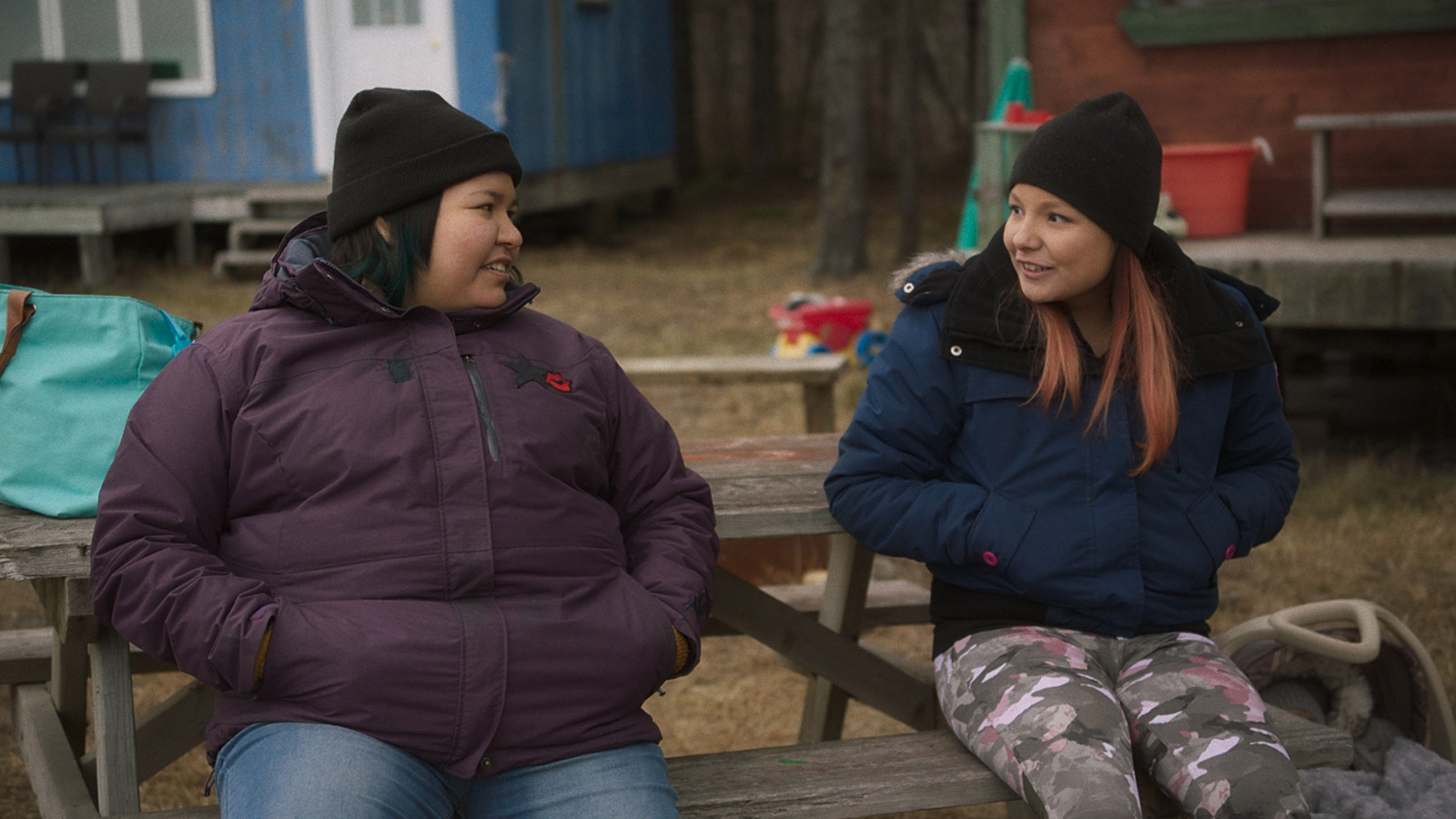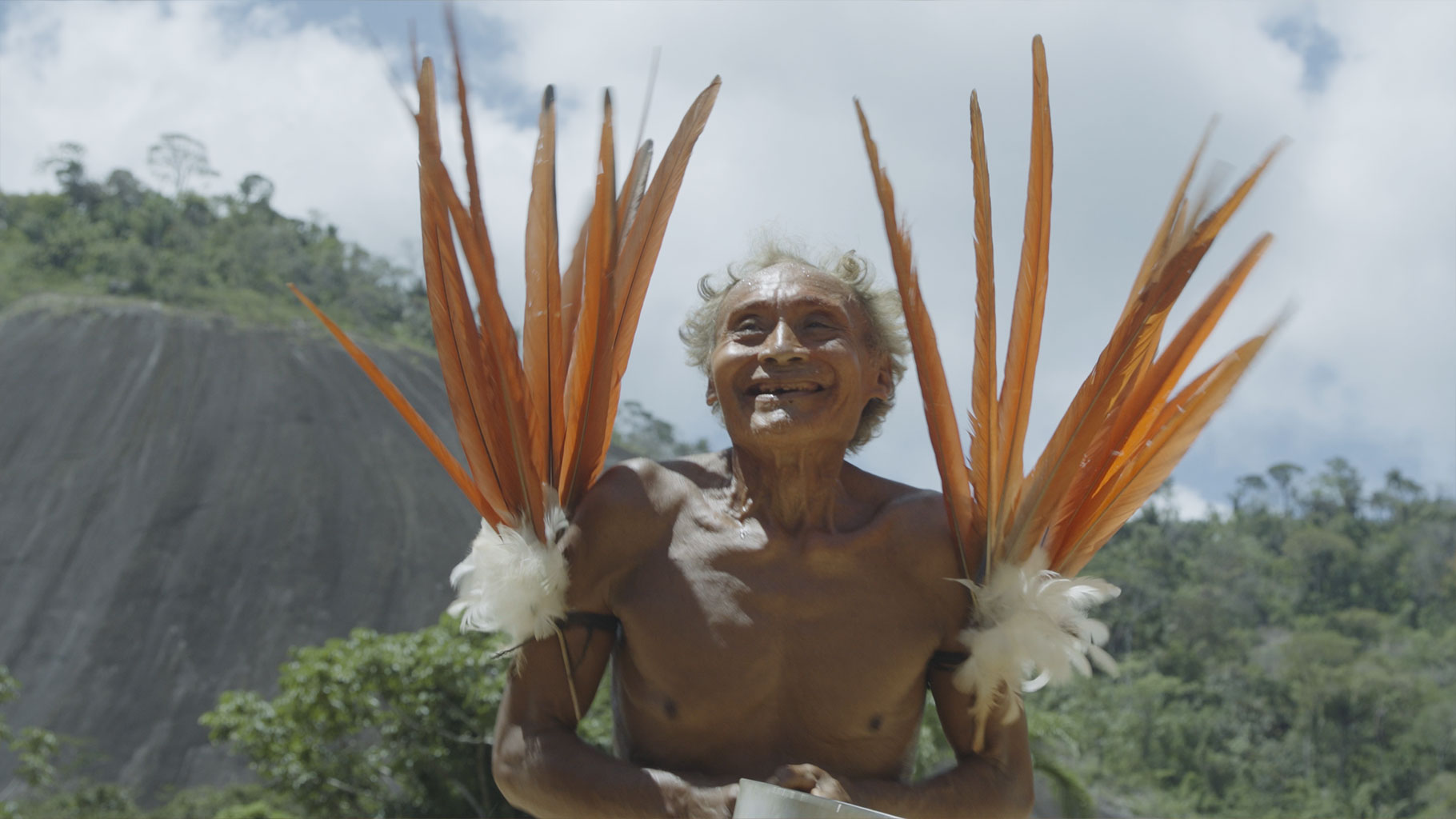
In 2010, Verreault was working on a documentary with the National Film Board of Canada centered around the impact of social media. While trying to seek out diverse perspectives and film subjects, she found herself on an Innu reserve. She was immediately taken.
“I grew up without knowing about them. I went to high school and college and university and am an educated girl, but I didn’t know anything about them, [even though] they live close to my town,” reflects Verreault, in her thick French-Canadian accent. “This is so mind-blowing, and that’s why I was fascinated when I discovered that place and met those people.”
Verreault’s first impulse was to work with them and to know them. She understood that as a white woman and an outsider, she was not in the position to tell their story without their blessing.
“It’s a movie I cannot make without them,” Verreault explains simply.
And that’s when the work began.

Real Life as Fictional Life
Presented in a mix of the Innu language and French, Kuessipan is carried by the expertise of amateur actors who show the nuances of modern life on the Uashat reserve. Verreault’s desire to work with non-professional actors mirrors the process of her first feature film, West of Pluto / À l’ouest de Pluton (2008), which told the story of her upbringing near Quebec using scripted stories told by high schoolers.
“I took the real people of the suburb of Quebec City, so the place and the people are so similar. They fit. And I wanted to repeat that…” Verreault explains. “But the first movie was about my town and my culture and my teenage life… [With Kuessipan, it was a project where I was an imposter. I didn’t know those people, so I needed someone who would be the eyes of the project.”
After that point, Verreault came upon Naomi Fontaine’s Kuessipan, a short, poetic book which — in just about two hundred pages — captures a hopeful but melancholic feeling of life in an Innu community. Verreault felt compelled to bring these emotions to the silver screen.
“The first question I asked Naomi, was, ‘Do you want to make a movie with me?’ And it was not, ‘Can I adapt your book?'” says Verreault. “It is very difficult to adapt that book, because it is not a linear story… It’s very poetic; it’s in prose…”
“I began to write a script with Naomi Fontaine, but when we were in the process of writing, I was constantly returning to the book, because the book contained everything,” she continues.

Kuessipan‘s main characters — Mikuan, played by Sharon Fontaine-Ishpatao, and Shaniss, played by Yami Gregoire — do not exist in the book, but their stories do. On-screen, Shaniss is a young mother whose pride around motherhood ties into deeper feelings of survival and the passing on of wisdom to the next generation of Innu people. It deeply struck Verreault that while abortion would have been a common consideration in her culture, it seemed a distant possibility in Fontaine’s book.
“When I read that book, I had so much emotion about the young girl that had babies at 16-years-old…” reflects Verreault. “But they don’t think about that and don’t speak about that, and it’s so normal in their culture. It’s full of love and full of tenderness the way Naomi was looking at those girls… you have the feeling of, ‘That’s the way it is. That’s the way it is,’ and with no judgment.”
Yet not all aspects of living on a reserve are portrayed glowingly in Kuessipan. Struggles with domestic abuse, alcoholism, and family instability can be seen, along with other impacts of ongoing colonization.
“If you live in a culture where the population is maybe fifteen or twenty thousand people…” says Verreault, of a character like Shaniss. “It must be very heavy on their shoulders if you are fifteen and you want to go out of your community, but you know that if you don’t stay, this culture will disappear.”
Mikuan’s plight is different. She is a writer and poet with big dreams — and after attending a poetry class in the city, she begins to date a white Canadian boy. When she asks him, “Do you find the reserve small?” he responds that he does. She then continues pensively, “I used to find it big. But it’s become too small.”
Later, Mikuan creates a great upset over a family meal when she reveals that she plans to go to college in Quebec City with her new boyfriend. In response, Shaniss snaps, “You have no pride. If everybody was like you, we wouldn’t exist.”
While casting both roles, Verreault sought Innu girls who were naturally similar to Mikuan and Shaniss in their day-to-day lives. Four hundred Innus showed up for the casting process for all the roles in the film — Verreault met two hundred of them personally, including nearly twenty potential actors for Mikuan and fifteen for Shaniss. She then invited three potential actors for Shaniss and two for Mikuan to attend a two-week workshop. After that period, it became evident who the lead actors would be.
“When I talked to Sharon Fontaine-Ishpatao the first time, it was Mikuan for me,” shares Verreault. “That kind of girl who thinks outside of the box and who wants go live in the city and have reflections on politics.”
Kuessipan also portrays other clashes between tradition and modernization. One partially-scripted piece is particularly profound. A classroom of teen actors were asked to improvise dialogue in response to a fictional scenario: what if an outside party wanted to extract resources from their land? The exercise yielded many responses related to autonomy and land sovereignty; certain debates were then repeated and incorporated into the film. The scene pulls viewers out of the narrative for just a moment — since it was filmed with two cameras and possesses a documentary feel that stands out from the rest of the film — but the choice was intentional.
“It’s a statement…” Verreault explains, regarding the perceived clash. “People don’t think they have something to say, or they think sometimes that Innu people think all the same on political issues because they see a blockade on the road… when you enter [the reserve] and you speak to people about politics, you see that there’s people more from the left mind and right mind.”

No Story About Them Without Them
In the early stages of creating Kuessipan, Fontaine served as an ambassador for Verreault to enter the Innu community, and this relationship meant everything for the success of the film.
“My first entrance into the community was her family, but over time, I met more people. It’s a really small community, so you’re used to knowing people very quickly,” explains Verreault, who then jokes that because Fontaine is so well-known there, Verreault was mostly known as “the white girl that worked with Naomi.”
By the end of the shoot, the relationship between the Innu community and the outside film crew had grown enormously. It was not simply “white people working behind the camera and the Innu in front of the camera,” according to Verreault, but a healthy mix of relationships.
“What was fun was because the white people were from Montreal — very far — they had to stay there during the weekend, so they went out with the Innu people,” says Verreault. “They were friends for real.”
Even two years after the release of the film, in 2019, the friendships remained. People from both communities still speak with one another, and crew from Montreal sometimes visit Uashat for their holidays.
“A lot of bridges were built with that project culturally, and they’re proud,” Verreault explains. This bridge-building was also evident the first time the filmmakers screened the film to guests — in a large space that held 800 and was a nearly fifty-fifty mix of Innu and non-Innu people.
“The Innu laughed at first because a lot of jokes are in the Innu language, so they would laugh, and then the white people would be like, ‘What?'” she recalls. “But they were crying at the same moments, so it was good that some emotion was universal.”
That emotional resonance is important, because making Kuessipan was difficult at first; many people told Verreault that a story about the Innu community would not be marketable. Luckily, its release has been successful, especially abroad in France — and the film continues to present opportunities for education.
“I know a lot of my friends and my parents and families that didn’t know anything about Innu,” shares Verreault. “Because it’s a Quebec movie produced by a Quebec production company, and with a budget, they go see the film in theaters and they discovered a totally new culture…”
Yet Verreault is cautious about ascribing too much power to her own work. Though she knows that Kuessipan will open some doors for Native and Indigenous storytelling, she recognizes the longstanding history of racism and says, “It’s not a movie from a white girl that will change all that.”
“This is a long fight for them, and there are so many people from this community and other Native communities that have fought so much for years, so I will not say that my movie will change everything. It would be so arrogant, I think,” she continues. “But I’m with them.”
Indeed, while the film industry is late in creating opportunities for diverse storytellers to lead their own narratives, viewers have long wanted to watch diverse stories. Verreault is firm that Native filmmakers have to tell their own stories much more, and that she sees herself now as a bit of a mentor.
“I don’t think I will make other movies with Innu people, because I see a generation of Native filmmakers that are so talented — young and with a lot of ideas and a lot of stories to tell — so I will be very pleased to help them make their way in the industry…” she offers.
“I think cultural appropriation is a very important issue and a debate that we have to have in this society, because so many people do that with no respect,” Verreault says finally. “It’s not forbidden to make movies with a point of view that is exterior to another minority… but I think there’s a way to do it, and I think you can’t tell a story about them without them.”

Kuessipan Film Trailer
Ω







Hey, what a delight to run across your review in a completely random way! I’d just watched “Kuessipan” and was interested in learning more about the film. After winnowing my way through skimpy reviews, I was so glad to find a Redefine article on it. It proved to be satisfyingly meaty and answered a lot of questions I did, like how the filmmaking crew and community interacted (very gratifying to know they built a lasting rapport!). Thank you for asking all the right questions and publishing this sensitive, pithy, and well-written piece. Hope you’re doing well,Vee!